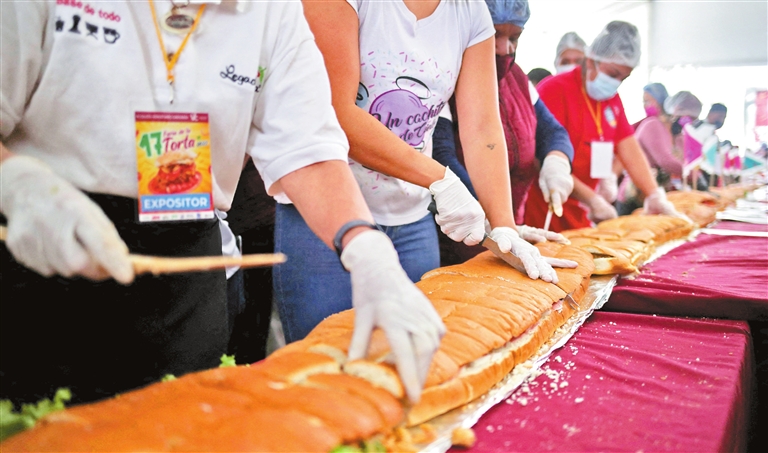
IN China — the land of hot noodles, steaming rice and warm soups — a new and unlikely food trend has swept across the country’s social media platforms in recent weeks. People have been sharing images of what most would consider incredibly bland foods, such as raw carrots wrapped in cheese, two-ingredient sandwiches and dressing-free salads — all unified by a single hashtag: #bairenfan. Translation: #Whitepeoplemeals. When exploring the images attached to this hashtag, you will find unappetizing pics of no-frills, cold, assembled dishes that require little or no cooking time — the kinds of foods many Westerners traditionally associate with lunch. The trend really started to take off in May, when people started posting photos and videos of these simple meals on social media platforms, though there are posts with the hashtag dating as far back as last October. In one such video, a woman on a train in Europe unwraps a plastic bag of lettuce and a bag of ham. She bundles them together, adds mustard and starts eating. Other posts feature photos of raw vegetables and basic sandwiches — think a single slice of bologna between two pieces of white bread — that Chinese netizens’ international colleagues or spouses have shared with them. As the trend spread, Chinese netizens around the world started sharing their own experiences with these minimalistic meals, making #bairenfan one of the hottest phrases on various platforms last month. The photos begged the question: Is that really what people in China think Caucasians eat all the time? “I feel it’s important to recognize that perception is an evolving concept,” says British Chinese chef Andrew Wong, the third-generation owner of London’s two-Michelin-star Chinese restaurant, A. Wong. In this case, the trend took only weeks to evolve. At first, most of the posts shared in China were filled with mockery and disbelief. “My Australian colleagues have expressed the ‘don’t-care’ spirit of white people meals to the extreme. It was a slice of bread last time. Now there are two carrots. The only ceremonial effort was putting them in a lunchbox,” wrote one user on Xiaohongshu, a popular Chinese social media site. Another user shared a lunchbox photo of two carrots with some baby spinach and expressed concern over whether its owner could “generate enough energy” with so little food. Others complained about feeling empty and soulless after eating such meals. And then the trend hit Twitter, with English-language users sharing their own photos and videos with the #whitepeoplemeals hashtag. (One such tweet gathered 4.3 million views in the last 3.5 weeks.) Many Twitter users, beyond the Chinese community, found the hashtag hilariously true. “Well, you can’t argue with this,” one user said. A Japanese Twitter user recalled her own experience in the United States: “I was kinda surprised that I saw people just bringing veggies in ziplock for lunch when I was an exchange student in the States.” As the hashtag went viral globally, some Chinese media reports expressed surprise at how quickly the international community embraced the stereotype. Multiple outlets reported that a new trending topic had emerged — #Whitepeoplemeals have been discovered by white people — and recapped the lighthearted responses from users around the globe. But that wasn’t the end of it. Another group appeared from the shadowy corners of the internet to show support for these simple meals, with a new hashtag — #Bairenfanyeshifan, or #whitepeoplemealsmatter — popping up on Chinese social media platforms. Some said eating such foods will help them lose weight. Others looked at the matter through a more serious lens, claiming the trend reflects a lifestyle and rising living costs in society. One post claimed that unlike full Chinese meals, these ones don’t make you drowsy, allowing you to avoid the urge to take an afternoon nap while at work. In addition to being deterred by the mere lack of taste and tiny portions of those so-called #whitepeoplemeals, many Chinese have expressed puzzlement with uncooked food in general. That’s because Chinese traditional medicine has long dictated that our bodies respond better to warm food and beverages. But what some of the viral posts fail to point out is that these simple cold foods are primarily only eaten at lunchtime. And there’s a historic reason for that, says Megan Elias, food historian and gastronomy director at Boston University. “In the mid to late 19th century, as the global north urbanized and industrialized, markets emerged for people to sell lunch to factory workers and office clerks,” she said. “The standardization of the lunch hour in factory settings gave people less time to eat and urbanization meant they might be far from home, so they were not able to cook. Lunch wagons and quick-serve coffee shops emerged especially in the United States to provide cheap and easy lunches that people could eat outside or in their work rooms.” Elias has written multiple books on food and culture, including “Lunch: A History.” She says sandwiches became the defacto lunch option at these wagons and shops because you can “get a variety of flavors into one package without much risk of spilling or any need to heat things up” in a limited time. “As the world gets smaller (and busier), eating convenient cold food, whether sandwiches, salads or Asian snacks, has become commonplace.” Elias says her lunches are similar to the ones posted under the hashtag “white people meals” — but often include dishes from other countries. (SD-Agencies) | 
